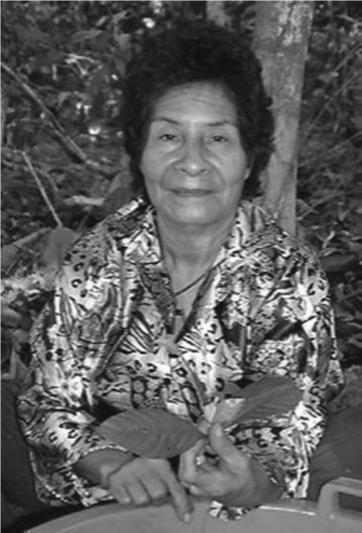Singing to the Plants: A Guide to Mestizo Shamanism in the Upper Amazon (53 page)
Read Singing to the Plants: A Guide to Mestizo Shamanism in the Upper Amazon Online
Authors: Stephan V. Beyer
Tags: #Politics & Social Sciences, #Social Sciences, #Religion & Spirituality, #Other Religions; Practices & Sacred Texts, #Tribal & Ethnic

Yellow oleander is used-as you would expect-as a purgative, and the leaves
are used to treat toothache, presumably because of their numbing effect in the
mouth. It is also considered an abortifacient, which is probably correct, given its
stimulatory effect on the muscles of the uterus.9
NOTES
1. Giese, 1989, p. 258.
2. Ratsch, 2007, p. 6o6. Interestingly, according to Ratsch (2007, p. 6o6), in Mexico,
just as in the Upper Amazon, the word cabalonga is used to refer both to Thevetia
peruviana and to a Strychnos species, Strychnos panamensis.
3. Bose et al., 1999; Caravati, McCowan, & Marshall, 2004, pp. 1699-1700; Frohne &
Pfander, 2005, pp. 56-57; Maringhini et at., 2002; Nellis, 1997, pp. 145-147.
4. Flomenbaum, 2002, pp. 1383-1384; Harris, 2007; Henry, Little, Jagoda, & Pellegrino, 2003, pp. 152-153; Lewis, 1998, p. 985; Williams, 2004.
5. Shneerson, 2005, p. 80.
6. Faust & Bianchi, 1998, p. 249.
7. Castner, Timme, & Duke, 1998, p. 121; Dewick, 2001, pp. 324-327; Duke &
Vasquez, 1994, p. 162; Plotkin, 1993, p. 309.
8. Mabit, 1996.
9. Castner et al., 1998, p. 124; Duke & Vasquez, 1994, p. 170.
AYAHUASCA RECIPES
Mestizo shamans often mix additional ingredients into the basic ayahuasca
drink. In addition to the ayahuasca vine and its companion chacruna, chagraponga, or sameruca, some shamans may, at different times, add plants
that are believed to modulate in some way the experience of the drink, such as
ajo sacha, ayahuma, bobinsana, capirona, catahua, chiricsanango, lobosanango, mapacho, maricahua, mucura, pucalupuna, toe, or other plants, any of
which may be psychoactive to one degree or another. 54
Some shamans add several different plants to the ayahuasca drink. Don
Roberto, for example, adds chiricsanango, toe, and maricahua. Other combinations of additional ingredients include bobinsana and lobosanango; toe
and camphor; mapacho, toe, and bobinsana; ajo sacha, mucura, and guayusa;
and toe, ajo sacha, and chiricsanango.ss This practice may be disputed. "It is
not always good to mix in so many things," says Pablo Amaringo. "It's better
to make it each time with the chacruna and, if he so wishes, he may add another plant, always one at a time." 56
Shamans may add plants to the basic drink for reasons other than to modify its psychoactive properties. For example, ayahuasca is a vine that requires
strong trees for support; by analogy, some shamans add the bark of large
strong trees to the drink-for example, huayracaspi, icoja, tahuari, and chullachaqui caspi-in order to provide similar support to those who drink it;57
the harder the wood, the more power it can deliver.58 Some add strong sweet
smells, such as agua de florida, for the protection such smells give; some add
tobacco for the same purpose. Some add plants to modulate the emetic effects ofayahuasca-oje, an emetic, or piripiri, an antiemetic.59 During la dieta,
plants and other substances may be added for purely experimental reasonsto let the ayahuasca transmit the teachings of the added plant, its spirit, its
uses, and its song.
COMBINATIONS
All of these potentially psychoactive materials may be consumed as part of la
dieta, during the ayahuasca healing ceremony, or on other occasions. During
a ceremony, the ayahuasca drink is seldom ingested in isolation; a shaman
may ingest in addition significant amounts of mapacho, toe, camalonga, piripiri, camphor, agua de florida, aguardiente, and other substances. Sometimes a caffeine-rich infusion of guayusa is drunk-or its leaves are mixed into the ayahuasca drink-in order to kill the bitter taste of ayahuasca and, it
is said, prevent a hangover the next morning.b°
Over a career, a shaman has consumed an incredible variety of substances-not only hundreds of different plants but also any number of commercial products, including agua de florida, Timolina, Creolina, and camphor,
often in combination. Don Roberto, for example, regularly drinks a mixture
of camphor, camalonga, and aguardiente; dona Maria regularly drank a mixture of mapacho, camphor, camalonga, and agua de florida. Since these commercial products have genios, spirits, shamans may diet with them: Artidoro
Aro Cardenas, a perfumero, has dieted with agua de florida, Timolina, and camalonga;bi don Emilio Andrade Gomez has dieted with, among other things,
agua de florida, camphor, and Creolina.12 Clearly, the potential for complex
synergistic and antagonistic interactions is immense.

SOURCES OF MESTIZO SHAMANISM
Mestizo shamans derive their practices from numerous sources-the indigenous shamanism of the Upper Amazon, folk Catholicism, popular plant
lore, traditional Hispanic medical theories and diagnoses, and the images and
symbols of European biomedicine. I think of don Roberto, dressed in a crown
of feathers and a shirt painted with Shipibo designs, welcoming spirits who
descend from the sky in the form of extraterrestrial doctors speaking computer language; or dona Maria, dressed in a white coat like a biomedical doctor, singing the Ave Maria as a spell of protection before drinking ayahuasca.
Guillermo Arevalo, a Shipibo shaman, says, "Right now in the Amazon, we
can't say that there's any pure tradition. It's mixed. Even the indigenous are
fusing together different cultural beliefs. This is not a bad thing, it's natural.
When it comes out of positive intention, it's good. "I
THE UPPER AMAZON AS A CULTURE AREA
Mestizo shamans are recognizably part of a larger Upper Amazonian religious
culture area, characterized by a number of common features-the use of
psychoactive plants; the presence of magical substances kept within the shaman's body; notions of sickness as caused by the intrusion of pathogenic objects; the ambiguity of shamanic ability to do both good and evil; the central
sacrality of tobacco; the acquisition of songs from the spirits; the use of songs
for the creation of both medicines and poisons; a focus on healing with the
mouth through blowing and sucking; and the importance of singing, whistling, blowing, and rattling in both healing and sorcery.

FIGURE 12. Dona Maria with chacruna.
Travel and exchange have occurred throughout the western Amazon since
long before the arrival of Europeans. What seems to the unfamiliar eye to be
a vast undifferentiated landscape is in fact threaded with riverine highways
navigable over long distances in dugout canoes. In addition to efficient canoe
transport, indigenous people in the Amazon have always been able to cover
long distances on foot, even carrying heavy loads, with remarkable speed.
Anthropologists Blanca Muratorio and Michael Taussig have both provided
nineteenth-century paintings and engravings that show indigenous porters
carrying heavy burdens through the jungle highlands, including white men
wearing frock coats and Panama hats, sitting on chairs strapped to the porter's back.2
Cultural exchange has been facilitated by trade throughout this area, dating back to pre-Columbian times, in such products as pita fiber, gold, salt,
cotton, cinnamon, tropical fruits, and feathers; by rules of exogamy that require taking a bride from a village that speaks a different language; and by
herbalists, traveling far distances, collecting medicinal plants from the Pacific
coast to the lowland jungle, setting their blankets in the small markets, covered with their roots and stems, bark and leaves.3 Arrow poisons have been widely used in this area, and the similarity of names-curare, wourali, ourari,
urali-indicate the frequent exchange of ideas and ingredients .4
The process of cultural exchange was accelerated by European colonization, when missionaries forced indigenous people to live together in reducciones, regardless of their tribal distinctions, so they could more easily be
converted and controlled; and in particular by the rubber boom, where indigenous and mestizo people from the entire area, bound together by slavery
and debt peonage, were transported long distances and put to work together
as rubber tappers.5 This process of interchange continues today in the urban
slums of Iquitos and Pucallpa, in smaller Amazonian towns, and in the Peruvian army, in which local healers, thrown together with distant practitioners,
have traditionally been able to exchange ideas.' Protestant missionaries use
their light planes to fly indigenous people to large evangelical prayer meetings, where their guests use the opportunity to arrange marriages, negotiate
political alliances, exchange news, and consult famous shamans-and where
shamans can consult with each other.?
